Reviewed: Game Soundtracks I have loved
Updated August 29, 2007
I'm a musician so I tend to listen pretty closely to any sound going on around me. This includes both the popular and the less spotlighted world of instrumental music, including soundtracks for all sorts of entertainment media.
Lately I'd been organizing my play lists where I work and I noticed that I had been hanging on to several soundtracks from video games all this time and still enjoying them without playing the game. That sort of got me thinking about all those tracks and why I've hung onto them so I've sort of plopped it down here for posterity.
Of course it's illegal to provide samples of the music I'm writing about, but I'll try to provide dependable links to places with samples if I can.
Here is my take on some of the good stuff that seems to have stood the test of time:
Descent II
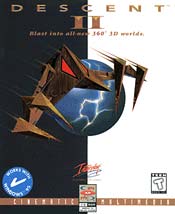
The Descent series of games had a good run before seemingly fizzling out after Descent III was released in 1999. There was a Descent IV in development but it was cancelled.
Descent was intoxicatingly visual with it's 360 degree control through three-dimensional tunnels where you were basically taking out evil robots with missiles and gunfire. It was fun. I don't remember the original Descent music at all - so I should revisit that and see if it's anything good. Descent II and III had good music, but I was especially keen on Descent II.
Like many games in 1996 the soundtrack was part of the game CD-ROM as added "Red Book" standard audio CD tracks that the game simply instructed the CD drive to play. This saved CPU cycles for doing all the 3D graphics. The neat side-effect of this was the loss of the real-time MIDI-based soundtrack for studio-produced music with full CD quality. D2 actually had a MIDI soundtrack and the CD audio version too. I pretty much ignored the MIDI-based score. The CD audio was a great high-energy ride with big mixes and lots of layers. It really kept the game moving and you on your toes amidst the action.
This was essentially a techno industrial score, with added guitar work and some nice layered arrangements. I really enjoyed it. I probably played more of the game because of the music working so well with the game play.
Many of the tracks were composed by Mark Walk (Type O Negative) and Ogre (Skinny Puppy) as well as some other composers: Johann Langlie, Ron Valdez, Brian Luzietti, Mark Morgan, Larry Peacock (no relation to me), Brad Cross and Leslie Spitzer. It gets confusing with later re-releases of the game that had extended remixes and alternate versions unlike the original. Basically more than one version of the Descent II music existed.
I played the Macsoft version of Descent II, so it was likely the original tracks from the first release of the game.
As I mentioned above, Descent III also had a good soundtrack. Sadly I played less D3 because it was a bit bug-ridden and at the time I had to shut the music down to even play the game at a decent frame rate. I'd like to revisit the game at some point, if it's even possible on the current operating systems.
Fallout
Fallout 2
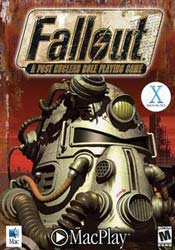
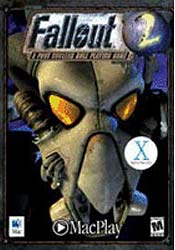
Fallout was introduced in 1997 and Fallout 2 was released in 1998. Both games have similar sonic characteristics and from what I can remember the same composer Mark Morgan. Like Diablo II this is an ambient soundtrack that is built on establishing moods as it constantly shifts and fades seamlessly throughout the game. These games were all about a dark gritty future strangely lovable in its own way.
The music is dense and filled with references to various cultural themes. Lots of it is spread out among drones and eerie atmospheric sounds. Mostly it really worked well with the game, like long drone-based sounds while you're traveling across uncharted desert that completely felt right amidst the isolation. The music conveyed the same sense of despair that the games provided, but wasn't overly dark all the time.
Diablo II
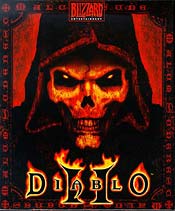
Diablo II was probably destined to be successful regardless of it's audio elements. The original Diablo was immensely popular despite basically having simple "click-and-kill" gameplay. The Diablo series was in essence a well-produced game that supported being played in a mindless haze. The rewards of playing were in building your character stats and getting unique or magical items that made you oh-so-badass against hoards of hell-spawned monsters. This was a hero's battle to save the world, playable both as a solo experience or in its better incarnation online with friends from all over at your side. Cooperative game play is actually a fun endeavor, and Diablo II was one of the better online games to first arrive in the market (this was in 2000).
It should be noted that I played a lot of Diablo II during moments of post-work haze. I played solo, not online since at my age finding time to play friends online isn't so easy with all the adult responsibilities the world contains. I played it because it was a well produced game visually but mostly because I liked the overall ambient sounds and music.
There isn't much dialogue in Diablo II, so that distraction isn't so much of an issue. When characters speak it's usually not a jarring experience like in so many other games. It has to be said that Blizzard does a nice job with its products.
The audio is a semi-ambient mix of sound effects and music all composed by Matt Uelmen. I will omit the first Diablo from this write-up, but Matt did the music for that as well and it was also good. In DII it's just great to crank up the dense atmospheric sound above the combat sound effects and zone out for a bit to it. I've always had a favorite track from this game, called "Harem" from the second act. Harem is a (Hindi?) vocal piece with an unusual time signature emphasized by its rhythmic elements.
Much of the D2 soundtrack has a world-music theme, as well as horror film types of sounds. The whole experience is also solidly mixed and just sounds great. Remembering that sound is half of a media experience explains why I could tolerate the game at all.
Diablo II was expanded with the Lord of Destruction add-on sometime in 2001. This soundtrack differed greatly from the core Diablo II game and though well produced did very little for me.
Katamari Damacy
We Love Katamari
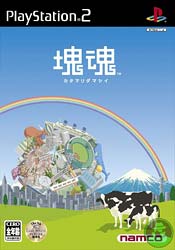
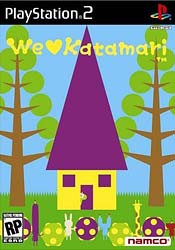
Who would have thought a $20 game with a simple story and primitive graphics would come with one of the most fun and catchy soundtracks I've heard for any game. To put it out there, the soundtrack is awesome. Listening to it by itself is much less intriguing but while playing the game the music is diverse and fun.
Katamari Damacy probably needs no introduction if you're on top of the PS2 community, it's been extremely popular because it's quite fun and weird in the most entertaining way. The music reflects that completely without sticking to any one compositional genre. Even when pop-ish it's quirky and eccentric. Other tracks fall into jazz or plain electronica (for kids?) and there is even a Fugue that is orchestrated electronically to resemble something by the great Wendy Carlos. It all just feels right.
When playing this game you notice the soundtrack more than you would in some games and you'll probably find yourself humming it for days afterward, especially the main theme that accompanies the awesome surreal animated intro that runs every time you load up the game.
The sequel, We Love Katamari, maintains the quality of the original as far as catchy songs and music go offering almost a completely new song list with some remixed and revised revisions of the awesome original theme. But like most sequels it doesn't seem to be as good even though the game play improved in a lot of areas. I'd say it's still above average. This is more of a case of setting a higher standard to begin with and you can never touch that with a sequel.
Splinter Cell: Chaos Theory
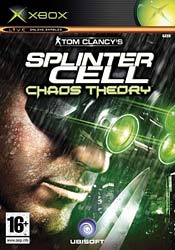
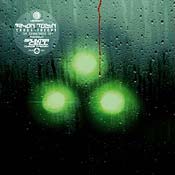
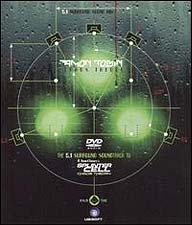
Ubisoft, the French-based company behind this game, has already established itself as capable of producing some nice looking and sounding games (even in the voice acting). So this is where things aren't quite right in that I've never played Splinter Cell Chaos Theory, and in fact it's about to ship as I write this. In an unusual move the soundtrack has been released on CD prior to the game in a special mix by the artist Amon Tobin on his usual label Ninja Tune.
Having Amon Tobin doing a game soundtrack for a military stealth game is a new twist, so in a way it's a good sign that Ubisoft sought AT out to produce this. From the various 'net interviews with the artist it appears that the game play soundtrack will auto-mix layers of looped music depending on game events. Not uncommon in games at all, but again this isn't going to be just any music. The CD is very much like Amon Tobin's other work in style, but I prefer it to his prior release Out From Out Where. It's rather dramatically arranged and moves successfully through imaginable events. It's a good listen while working as a lot of instrumental music should be.
In addition to the audio CD there is 5.1 DVD audio version of the soundtrack, which is what I own so I've listened to this the most. It's a different track order than the audio CD and of course has the large sound only a surround mix can have. It's big and spatial and for me shows a completely different picture of how Amon Tobin's music is assembled.
The surround sound DVD is the best way to experience this music outside of the game and the DVD comes with a data partition containing high-quality digital audio files of the material. So the DVD is the best bang for the buck. The game is in 5.1, so the standard two-channel CD is probably going to be less interesting than a surround mix anyway. Regardless of whichever version this soundtrack worth a listen.
Killer 7
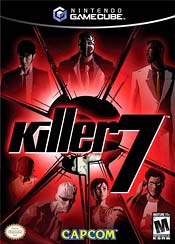
Capcom has a long history of point and shoot games (like the Resident Evil series) and on the surface Killer 7 is another game with a gun, but it's far more than that. As far as story and overall surrealism this game is in its own league, but sadly I felt the game play wasn't as interesting as the story and the design within the game itself. There are places where the game wasn't really all that fun, so I'd plug onward and be rewarded when things picked up again. Despite those lulls, this game is worth playing anyway. It's got rough edges in a good way, and the look of the cell-shaded art is handled very specifically and at times very spectacularly. And it's a complex tale of multiple personalities, political espionage and the fate of one of the seven protagonists - with a twist at the end. It won't insult your intelligence either, you will have to use your head when considering some of the events in the story.
And now on to the music: the music is one of the slickest parts of the game - half the experience as it should be. There is a lot of it even though various segments are replayed at areas you return to many times. It carries the mood and events quite well. Each chapter is different in the game and the music follows that while feeling consistent and whole. It's interesting stuff, at times a bit experimental but always tight and produced with a slick edge. There is techno, melancholy ambience, heavy rock, almost country, island or world and all the soundtrack elements you would expect in between. I'd venture to comment that the music in Killer 7 is probably more interesting that most of the games in the past few years. It just works. Most of it was composed by Masafumi Takada with a track or two by Jun Fukuda.
Shadow of the Colossus
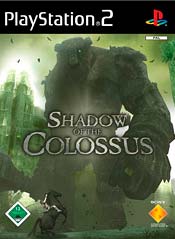
In 2005 gamers got a long-awaited treat with Shadow of the Colossus. A Playstation 2 exclusive like it's related prequel (or sequel) Ico, this game oozes cinematic immersion.
Primarily orchestral, the soundtrack is big and strong during the battles with the enormous creatures the game is named for. In other parts of the game the music becomes almost invisible. This is a game that understands space and the power of silence.
The composer is Kow Otani. His work for Colossus really feels like a film score. The game is both huge and strangely intimate in its handful of characters. As the protagonist you work your way through 16 unique colossi, bringing each one down with a heartfelt sadness that is carried by the descending lines of the music that starts to play as each colossus falls and dies. This isn't the adrenalin pumping techno score, it's all sweeping sonics that convey the beautiful design in the game. Shadow of the Colossus is one of the best games of this generation, if not the best so it has to be no surprise I've included it here.
I even played this game to different music and it worked surprising well. Sort of by accident I ended up playing a "level" of the game while listening to the collaborative Hans Zimmer and James Newton Howard score for the film Batman Begins. With no intended disrespect to the game's provided score this fit quite well and seemed to sync up with the actions onscreen almost perfectly. Something to try if anyone is curious.
Honorable Mentions
Dark Colony
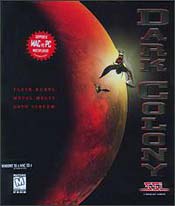
Dark Colony was an overlooked game for the most part. Having a similar real-time resource gathering and strategy game play it was basically one of the Warcraft clones on the market in 1997.
Dark Colony was produced by SSI, a company with a long history of historical war games going back to my 8-bit Atari days. SSI was a serious company that probably lost a lot of sales to the newer waves of games like Warcraft that had less real strategy and more slick art. It's unfortunate as they owned the strategic game market during the days of 8-bit home computers.
The soundtrack was provided as Red Book audio tracks on the CD. The game data was large enough that there were only 3 tracks of music that would cycle through over and over while playing. But this stuff worked with the game and I enjoyed the music at the time.
Each track was different, ranging from electro-symphonic to completely ambient. Usually the ambient track would come up when it would turn to night in the game, having an eerie but beautiful effect. Compared to the other games I write about here, this would be my least favorite, but I feel that the game worked really well with the music despite the small number of compositions. Oddly one of the tracks uses some symphonic samples that I have in my own sample library that came with my Yamaha A3000 sampler a long time ago.
The tracks for this game were composed by Barry Blum and Sergei Kuprejanov. Based on my limited research neither of these men has done any other music since.
Metroid Prime & Metroid Prime II: Echoes
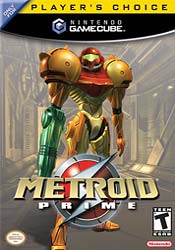
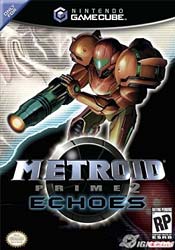
A lot of people probably really like the newer Gamecube Metroid soundtracks, and I'm about 50/50 on them myself. That's probably because they're true to the original theme which had it's own catchy almost X-Files-esque melody. And gamers seem to have a good grasp of nostalgia, so when the game was updated to a partial FPS in full 3D from it's 2D side-scrolling roots, the music had to be updated but stay true as well.
As far as I know the music is the sole work of composer Kenji Yamamoto, whom I know nothing about though he did do the Super Nintendo era Super Metroid as well as the Gameboy Advance Metroid Fusion.
The music is very electronic. The choir voice samples are what drive me nuts with this score. A lot of it uses that to set a sort of sacred mood while you explore ruined temples of a forgotten race. It's a solid idea but I'm distracted by the rather obviously synthesized choir voices used. Other sections of the game have a more minimalist feel, sometimes incorporating electronic effects more as sound effects would be than music. A lot of these are rather dominating and though they match the game I was quickly bored with the Magnamoor Caverns theme music as well as several other areas.
The fanfares and short themes played when upgrades and weapons are acquired are memorable and just feel right though, so it's not all bad. The credit sequence and game save load music are top-notch as well. They just set you up to play in an audible way. A lot of this works.
The more recent sequel (Fall 2004) had a very different musical approach in that I noticed it much less and it was less active on average. Reworked versions of some pieces from the original are there, but I have to say that even the re-worked title theme did nothing for me like the original. To me they're both good, but less intriguing after being played throughout the course of the games.
Beyond Good and Evil
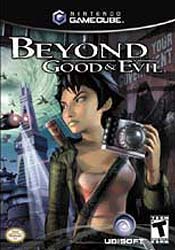
In 2003 the French game producer Ubisoft released Beyond Good and Evil Its one of those games that comes to mind as essentially easy to play but still somehow fun. And it looked great. It sold poorly but built up a bit of a slow burn based on great reviews and recommendations as well as getting a bargain price early in its life cycle. According to gaming news sites sequels will be developed even though originally the poor sales had eliminated that possibility.
Not all the music for this game did it for me, but I was impressed with the use of human beatboxing and super-fast cut up beats a la jungle which gave the game it's own ethnic/urban feel. The game is quite slick as far as graphics and design, it gas an air of cool about it in the styles of the characters and their environment. And the music feeds that, especially in the urban areas.
There is a strong South American batucada feel with dense Caixa-sounding percussion at times. Along with the tabla-esque beats it all feels really driven during active game play. The music is sequenced around the player confrontations like many games, so it streams with the action and keeps flow.
Other parts of the game had some nice ambience and then there were parts that didn't work for me, like the final boss fight. Taken as a whole I think it's a good soundtrack overall.
Christophe Heral composed the music. He's probably French like the publishing company behind the game. At the time of this writing I know nothing about him.